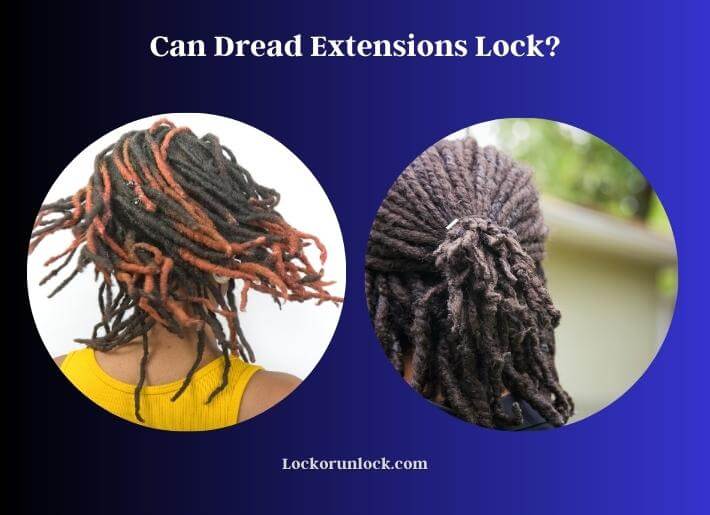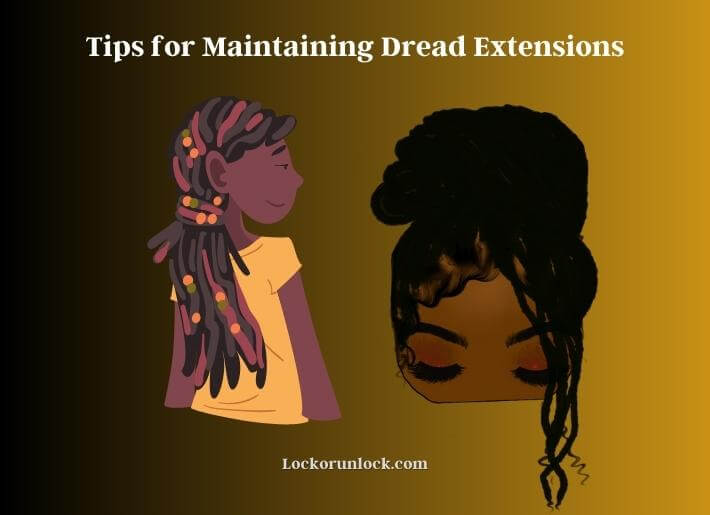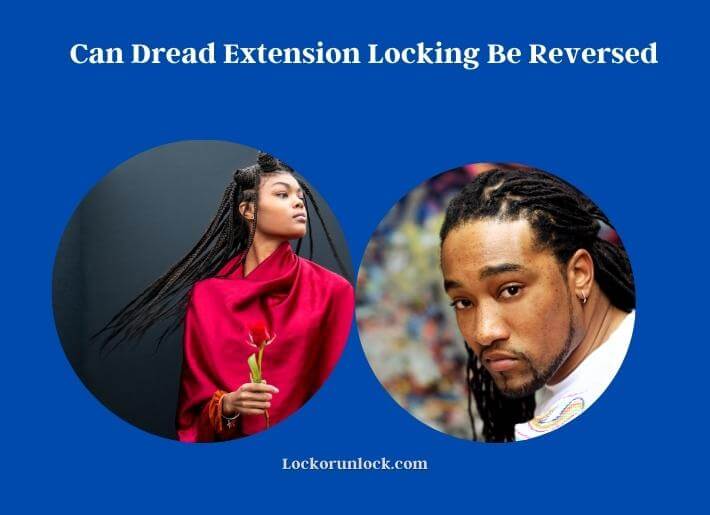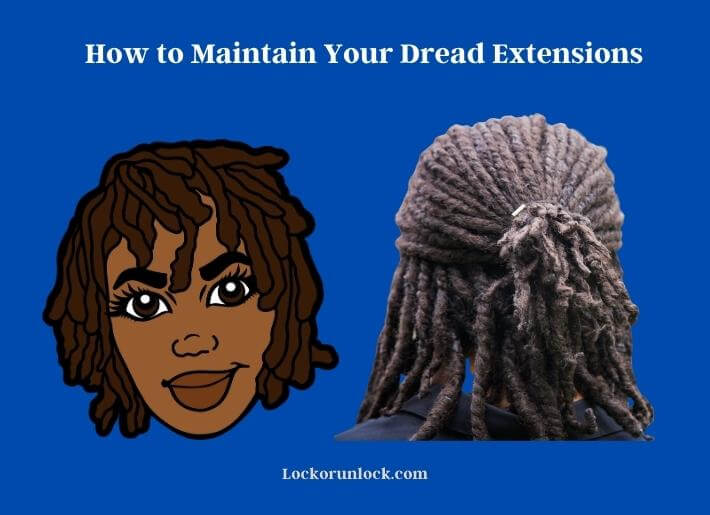Dreadlocks have been a popular hairstyle for centuries, with their unique and distinctive appearance drawing the attention of many people. While traditionally, dreadlocks were achieved by allowing the hair to grow and naturally mat together, today, many people opt for dread extensions as a quick and easy way to achieve the look.

Many people wonder whether dread extensions can actually lock onto the natural hair or if they’re simply a temporary fix.
Understanding Dreadlocks and Extensions
Before we delve into whether dread extensions can lock, let’s first understand what dreadlocks and extensions are. Dreadlocks are formed by matting and twisting the hair over time, creating a rope-like structure. The process can take months, even years, to achieve, but once the dreads are formed, they require regular maintenance to keep them healthy and well-groomed.
Dread extensions, on the other hand, are hair extensions that are designed to look like natural dreadlocks. They can be made from synthetic or human hair and are attached to natural hair using various methods, such as braiding or crocheting. They offer a quick and easy way to achieve the dreadlocked look without the long and arduous process of forming natural dreads.
Details About Dread Extensions Lock
The short answer is yes, dread extensions can lock. There are several factors to consider when it comes to the locking process. The main factor is the method used to attach the extensions. Crocheting is the most common method used, and it involves looping the extensions through the natural hair and pulling them tight. This process creates tension, which helps the extensions lock onto the natural hair.
Another factor to consider is the type of hair used for the extensions. Synthetic hair is less likely to lock than human hair because it does not have the same texture or density. Human hair, especially kinky or curly hair, is more likely to lock and blend in with natural hair.
It is important to note that dread extensions will not lock in the same way as natural dreads. They may look similar, but they will not have the same structure or integrity. Dread extensions require regular maintenance, such as tightening and reattaching, to keep them from unraveling.
Pros and Cons of Dread Extensions
Like any hairstyle, dread extensions have their pros and cons. Here are some of the advantages and disadvantages of getting dread extensions.
Pros
- They offer a quick and easy way to achieve the dreadlocked look without the long and arduous process of forming natural dreads.
- They can add length, volume, and thickness to your hair, which can be great for people with thin or short hair.
- They can be made from synthetic or human hair, giving you a wide range of options to choose from.
Cons
- They can be expensive, especially if you opt for human hair extensions.
- They require regular maintenance, such as tightening and reattaching, which can be time-consuming and costly.
- They may not look as natural as natural dreads and can be easily spotted as extensions.
Tips for Maintaining Dread Extensions
If you decide to get dread extensions, it is essential to take good care of them to ensure they last long and look great.

- Wash your hair regularly but avoid getting the extensions wet. Use a residue-free shampoo and a light conditioner.
- Avoid using heavy products on your hair, such as gels or oils, as they can weigh down the extensions and make them look unnatural.
- Keep the extensions dry and avoid swimming or getting them wet in the rain.
- Be gentle when brushing or styling your hair to prevent the extensions from unraveling.
- Get regular maintenance, such as tightening and reattaching, to keep the extensions looking great.
How to Encourage Dread Extension Locking?
Dread extensions can offer a quick and easy way to achieve the dreadlocked look without having to wait for your natural hair to grow and mat. For the extensions to lock onto your natural hair, certain steps need to be taken. Here are some tips to encourage dread extension locking:
- Choose the right type of hair: Human hair is more likely to lock than synthetic hair, so if you’re using synthetic extensions, keep in mind that they may not lock as well as human hair extensions.
- Use the crocheting method: Crocheting is the most common method used to attach dread extensions and involves using a crochet hook to pull the natural hair through the extension. This creates knots that allow the extensions to lock onto the natural hair.
- Don’t wash your hair too often: Washing your hair too often can cause the extensions to loosen and unravel, so it’s best to wash your hair every 2-3 weeks. When you do wash your hair, use a residue-free shampoo to avoid the buildup that can prevent the extensions from locking.
- Avoid using conditioner: Conditioner can make the extensions slipperier and prevent them from locking, so it’s best to avoid using it altogether.
- Be patient: It can take several weeks or even months for the extensions to fully lock onto your natural hair, so be patient and give them time to mat together.
- Avoid excessive brushing or styling: Brushing or styling your hair too much can cause the extensions to unravel, so be gentle when brushing and styling your hair and avoid using heat tools.
Can Dread Extension Locking Be Reversed?
Dread extension locking is a process that involves natural hair matting and intertwining with the extensions to create the desired dreadlocked hairstyle. While it can take several weeks or even months for the extensions to fully lock onto the natural hair, once they do, it can be difficult to reverse the process without cutting off the extensions. There are some methods that can help to loosen or remove dread extensions if desired.

One common method is to soak the extensions in hot water mixed with baking soda or apple cider vinegar. This can help to loosen the knots and make it easier to remove the extensions. This method can be harsh on natural hair and should be done carefully to avoid damaging the hair.
Another method is to use a special dreadlock removal tool, which can gently unravel the knots and allow the extensions to be removed without cutting the hair. This method can be more gentle on the hair than soaking, but it can also be time-consuming and may not be effective for tightly locked extensions.
It’s important to keep in mind that removing dread extensions can be a delicate process and should be done with care to avoid damaging the natural hair. It’s also important to properly care for the hair after removing the extensions to prevent damage and breakage.
Common Misconceptions About Dread Extensions and Locking
While natural hair is often used for dread extensions, it’s also possible to use synthetic hair. Synthetic hair may not lock as well as natural hair, so it’s important to choose high-quality extensions if you’re using synthetic hair.
While it’s true that dread extensions can be difficult to remove once they’re fully locked onto the natural hair, it is possible to remove them with the proper tools and techniques. It’s important to proceed with care to avoid damaging the natural hair.
While some people may associate dreadlocks with a lack of hygiene, this is not the case for those who properly care for their dread extensions. Regular washing and maintenance are key to keeping dread extensions clean and healthy.
Dread extensions can be worn by anyone regardless of hair type or texture. It’s important to choose the right type of extensions and to properly care for them to prevent damage or breakage.
While it’s true that proper maintenance is key to keeping dread extensions looking great, it doesn’t have to be a high-maintenance hairstyle. With the right tools and techniques, maintenance can be simple and easy.
How to Maintain Your Dread Extensions?
Maintaining dread extensions is key to keeping them looking great and healthy. Here are some tips for properly caring for your dread extensions:

- Regular washing is important for keeping your scalp and hair healthy. Use a shampoo that’s specifically formulated for dreadlocks, and be sure to rinse thoroughly to prevent buildup.
- A dry scalp can lead to itching and discomfort, so it’s important to keep your scalp moisturized. You can use a natural oil like coconut oil or a specially formulated scalp oil to keep your scalp hydrated.
- Heavy products like gels and waxes can weigh down your dread extensions and make them harder to maintain. Stick to lightweight products like oils and sprays to keep your hair looking and feeling great.
- Retwisting your hair helps to maintain the shape and tightness of your dread extensions. How often you retwist will depend on your hair type and the rate of growth, but generally, it’s recommended to retwist every 4-6 weeks.
- Sleeping with a silk or satin scarf or pillowcase can help to prevent frizz and keep your hair looking neat. You can also use a hair bonnet or tie your hair up in a loose bun before bed.
- Constant twisting, pulling, and repositioning of your dread extensions can cause breakage and damage to your natural hair. It’s important to handle your hair gently and avoid over-manipulation.
Potential Risks and Side Effects of Dread Extensions Locking
While dread extension locking can be a beautiful and versatile hairstyle, it’s important to be aware of the potential risks and side effects.
Scalp irritation: Tight or improperly installed dread extensions can cause scalp irritation and discomfort. This can be caused by the weight of the extensions pulling on the scalp or by the use of heavy products like waxes.
Hair breakage: Constant twisting and repositioning of dread extensions can cause breakage and damage to the natural hair. This is especially true if the extensions are too heavy or if they’re installed too tightly.
Thinning hair: Over time, dread extensions can cause the natural hair to become thinner or even fall out. This is especially true if the extensions are too heavy or if they’re not properly maintained.
Hygiene issues: Improper maintenance of dread extensions can lead to hygiene issues like buildup, odor, and even mold. It’s important to regularly wash and care for your dread extensions to prevent these issues.
Difficulty removing extensions: Removing dread extensions can be difficult and time-consuming. If the extensions are not properly removed, they can cause damage to the natural hair or even the scalp.
Cost: Installing and maintaining dread extensions can be expensive, especially if you opt for high-quality extensions or have them installed by a professional stylist.
How to Choose the Right Stylist for Your Dread Extensions?
Choosing the right stylist for your dread extensions is crucial to ensure that your hair is healthy, beautiful, and well-maintained.
Research
Look for stylists who specialize in dread extensions and have experience in installing and maintaining them. You can check online reviews or ask for recommendations from friends or family members who have had dread extensions installed.
Portfolio
Ask to see the stylist’s portfolio of previous work. This will give you an idea of their style and the quality of their work.
Consultation
Schedule a consultation with the stylist before you commit to having them install your dread extensions. This will give you the opportunity to discuss your hair goals and ask any questions you may have.
Technique
Ask the stylist about their technique for installing dread extensions. A good stylist will take into account the health and texture of your natural hair and recommend a technique that will minimize damage and maximize the lifespan of your extensions.
Products
Ask the stylist about the products they use for installing and maintaining dread extensions. High-quality products are important for ensuring that your hair is healthy and well-maintained.
Cost
Consider the cost of having dread extensions installed by the stylist. While it’s important to choose a stylist who is experienced and uses high-quality products, you also want to make sure that their services fit within your budget.
How Much Do Dread Extensions Cost?
The cost of dread extensions can vary widely depending on a number of factors, including the type of extensions you choose, the length and thickness of your hair, and the stylist you choose. Here are some general guidelines to keep in mind:
| Type of extensions | There are many different types of dread extensions, including synthetic, human hair, and wool. Synthetic extensions are typically the most affordable, while human hair extensions can be more expensive. Wool extensions are a relatively new option that can also be affordable. |
| Length and thickness | The longer and thicker your hair is, the more extensions you’ll need to achieve the desired look. This can add to the cost of your dread extensions. |
| Stylist fees | The cost of having your dread extensions installed by a stylist can vary widely depending on their experience, location, and the complexity of the installation. Some stylists may charge by the hour, while others may charge a flat rate. |
As a general guideline, you can expect to pay anywhere from $100 to $500 or more for dread extensions, depending on the factors mentioned above. It’s important to keep in mind that high-quality extensions and experienced stylists may cost more, but can also lead to better results and a longer lifespan for your extensions.
Can You DIY Dread Extensions?
While it is possible to do dread extensions yourself, it is generally not recommended unless you have experience in hairstyling and working with extensions. Installing dread extensions involves a number of steps, including sectioning the hair, backcombing, and twisting the hair into dreadlocks. It can be a time-consuming and complex process, and if not done correctly, can lead to damage or breakage of your natural hair.
Choosing the right type of extensions and products is crucial for achieving a natural and long-lasting look. DIY dread extensions may not use the same high-quality products that a professional stylist would use, leading to a shorter lifespan for your extensions.
If you are set on DIY dread extensions, it is important to do thorough research, practice on a small section of hair first, and use high-quality products. For best results and to avoid potential damage, it is recommended to seek the services of an experienced stylist for your dread extension installation.
If you want to know about understanding lock-related legislation and regulations, see here to know the answer.
Wrap Up
Dread extensions are a popular and versatile hairstyle that can be achieved through a variety of methods and with different types of extensions. While locking can be a natural process for some hair types, it can also be encouraged through techniques such as backcombing and twisting. It’s important to maintain your dread extensions properly to prevent damage to your natural hair and to ensure a longer lifespan for your extensions.
When considering dread extensions, it’s important to choose an experienced stylist who uses high-quality products and techniques to achieve the desired look. DIY installation is possible, but not recommended for those without experience in hairstyling and working with extensions.
Read More:
